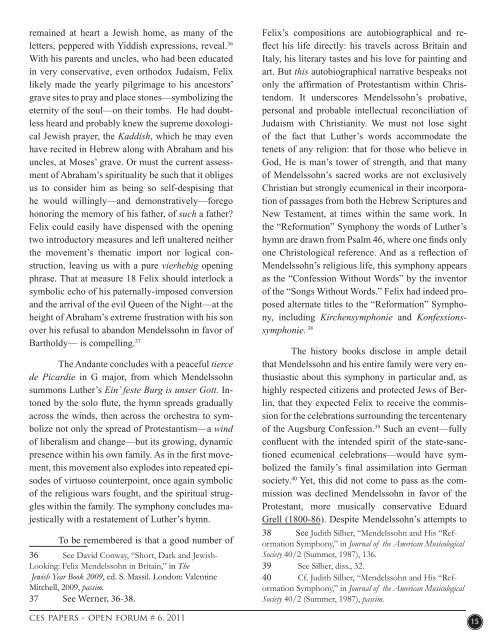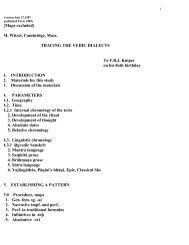references - people.fas.harvard.edu - Harvard University
references - people.fas.harvard.edu - Harvard University
references - people.fas.harvard.edu - Harvard University
Create successful ePaper yourself
Turn your PDF publications into a flip-book with our unique Google optimized e-Paper software.
emained at heart a Jewish home, as many of the<br />
letters, peppered with Yiddish expressions, reveal. 36<br />
With his parents and uncles, who had been <strong>edu</strong>cated<br />
in very conservative, even orthodox Judaism, Felix<br />
likely made the yearly pilgrimage to his ancestors’<br />
grave sites to pray and place stones—symbolizing the<br />
eternity of the soul—on their tombs. He had doubtless<br />
heard and probably knew the supreme doxological<br />
Jewish prayer, the Kaddish, which he may even<br />
have recited in Hebrew along with Abraham and his<br />
uncles, at Moses’ grave. Or must the current assessment<br />
of Abraham’s spirituality be such that it obliges<br />
us to consider him as being so self-despising that<br />
he would willingly—and demonstratively—forego<br />
honoring the memory of his father, of such a father?<br />
Felix could easily have dispensed with the opening<br />
two introductory measures and left unaltered neither<br />
the movement’s thematic import nor logical construction,<br />
leaving us with a pure vierhebig opening<br />
phrase. That at measure 18 Felix should interlock a<br />
symbolic echo of his paternally-imposed conversion<br />
and the arrival of the evil Queen of the Night—at the<br />
height of Abraham’s extreme frustration with his son<br />
over his refusal to abandon Mendelssohn in favor of<br />
Bartholdy— is compelling. 37<br />
The Andante concludes with a peaceful tierce<br />
de Picardie in G major, from which Mendelssohn<br />
summons Luther’s Ein’ feste Burg is unser Gott. Intoned<br />
by the solo fl ute, the hymn spreads gradually<br />
across the winds, then across the orchestra to symbolize<br />
not only the spread of Protestantism—a wind<br />
of liberalism and change—but its growing, dynamic<br />
presence within his own family. As in the fi rst movement,<br />
this movement also explodes into repeated episodes<br />
of virtuoso counterpoint, once again symbolic<br />
of the religious wars fought, and the spiritual struggles<br />
within the family. The symphony concludes majestically<br />
with a restatement of Luther’s hymn.<br />
To be remembered is that a good number of<br />
36 See David Conway, “Short, Dark and Jewish-<br />
Looking: Felix Mendelssohn in Britain,” in The<br />
Jewish Year Book 2009, ed. S. Massil. London: Valentine<br />
Mitchell, 2009, passim.<br />
37 See Werner, 36-38.<br />
ces papers - open forum # 6, 2011<br />
Felix’s compositions are autobiographical and refl<br />
ect his life directly: his travels across Britain and<br />
Italy, his literary tastes and his love for painting and<br />
art. But this autobiographical narrative bespeaks not<br />
only the affi rmation of Protestantism within Christendom.<br />
It underscores Mendelssohn’s probative,<br />
personal and probable intellectual reconciliation of<br />
Judaism with Christianity. We must not lose sight<br />
of the fact that Luther’s words accommodate the<br />
tenets of any religion: that for those who believe in<br />
God, He is man’s tower of strength, and that many<br />
of Mendelssohn’s sacred works are not exclusively<br />
Christian but strongly ecumenical in their incorporation<br />
of passages from both the Hebrew Scriptures and<br />
New Testament, at times within the same work. In<br />
the “Reformation” Symphony the words of Luther’s<br />
hymn are drawn from Psalm 46, where one fi nds only<br />
one Christological reference. And as a refl ection of<br />
Mendelssohn’s religious life, this symphony appears<br />
as the “Confession Without Words” by the inventor<br />
of the “Songs Without Words.” Felix had indeed proposed<br />
alternate titles to the “Reformation” Symphony,<br />
including Kirchensymphonie and Konfessionssymphonie.<br />
38<br />
The history books disclose in ample detail<br />
that Mendelssohn and his entire family were very enthusiastic<br />
about this symphony in particular and, as<br />
highly respected citizens and protected Jews of Berlin,<br />
that they expected Felix to receive the commission<br />
for the celebrations surrounding the tercentenary<br />
of the Augsburg Confession. 39 Such an event—fully<br />
confl uent with the intended spirit of the state-sanctioned<br />
ecumenical celebrations—would have symbolized<br />
the family’s fi nal assimilation into German<br />
society. 40 Yet, this did not come to pass as the commission<br />
was declined Mendelssohn in favor of the<br />
Protestant, more musically conservative Eduard<br />
Grell (1800-86). Despite Mendelssohn’s attempts to<br />
38 See Judith Silber, “Mendelssohn and His “Reformation<br />
Symphony,” in Journal of the American Musicological<br />
Society 40/2 (Summer, 1987), 136.<br />
39 See Silber, diss., 32.<br />
40 Cf. Judith Silber, “Mendelssohn and His “Reformation<br />
Symphony,” in Journal of the American Musicological<br />
Society 40/2 (Summer, 1987), passim.<br />
15

















